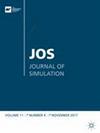Simheuristic and learnheuristic algorithms for the temporary-facility location and queuing problem during population treatment or testing events
IF 1.3
4区 工程技术
Q4 COMPUTER SCIENCE, INTERDISCIPLINARY APPLICATIONS
引用次数: 1
Abstract
Epidemic outbreaks, such as the one generated by the coronavirus disease, have raised the need for more efficient healthcare logistics. One of the challenges that many governments have to face in such scenarios is the deployment of temporary medical facilities across a region with the purpose of providing medical services to their citizens. This work tackles this temporary-facility location and queuing problem with the goals of minimising costs, the expected completion time, population travel time, and waiting time. The completion time for a facility depends on the numbers assigned to those facilities as well as stochastic arrival times. This work proposes a learnheuristic algorithm to solve the facility location and population assignment problem. Firstly a machine learning algorithm is trained using data from a queuing model (simulation module). The learnheuristic then constructs solutions using the machine learning algorithm to rapidly evaluate decisions in terms of facility completion and population waiting times. The efficiency and quality of the algorithm is demonstrated by comparison with exact and simulation-only (simheuristic) methodologies. A series of experiments are performed which explore the trade-offs between solution cost, completion time, population travel time, and waiting time. © 2023 The Operational Research Society.群体处理或测试事件中临时设施位置和排队问题的模拟启发式和学习启发式算法
疫情爆发,如冠状病毒疾病引发的疫情,提高了对更高效医疗物流的需求。在这种情况下,许多政府必须面临的挑战之一是在整个地区部署临时医疗设施,为其公民提供医疗服务。这项工作解决了这个临时设施的位置和排队问题,目的是最大限度地减少成本、预期完工时间、人口出行时间和等待时间。设施的完工时间取决于分配给这些设施的数字以及随机到达时间。本文提出了一种学习启发式算法来解决设施选址和人口分配问题。首先,使用来自排队模型(模拟模块)的数据来训练机器学习算法。然后,学习启发式使用机器学习算法构建解决方案,以根据设施完成情况和人口等待时间快速评估决策。通过与精确和仅模拟(simheuristic)方法的比较,证明了该算法的效率和质量。进行了一系列实验,探讨了解决方案成本、完成时间、人口旅行时间和等待时间之间的权衡。©2023运营研究学会。
本文章由计算机程序翻译,如有差异,请以英文原文为准。
求助全文
约1分钟内获得全文
求助全文
来源期刊

Journal of Simulation
COMPUTER SCIENCE, INTERDISCIPLINARY APPLICATIONS-OPERATIONS RESEARCH & MANAGEMENT SCIENCE
CiteScore
5.70
自引率
16.00%
发文量
42
期刊介绍:
Journal of Simulation (JOS) aims to publish both articles and technical notes from researchers and practitioners active in the field of simulation. In JOS, the field of simulation includes the techniques, tools, methods and technologies of the application and the use of discrete-event simulation, agent-based modelling and system dynamics.
 求助内容:
求助内容: 应助结果提醒方式:
应助结果提醒方式:


